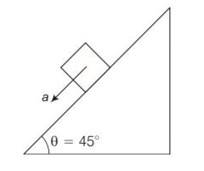Class 11th
Get insights from 8k questions on Class 11th, answered by students, alumni, and experts. You may also ask and answer any question you like about Class 11th
Follow Ask QuestionQuestions
Discussions
Active Users
Followers
New answer posted
4 months agoContributor-Level 10
This is a assertion and reason answer type question as classified in NCERT Exemplar
option (i). Both A and R are true and R is the correct explanation of A.
New answer posted
4 months agoContributor-Level 10
This is a matching answer type question as classified in NCERT Exemplar
(i) - B
(ii) - C
(iii) - A
New answer posted
4 months agoContributor-Level 10
This is a Long Answer type Questions as classified in NCERT Exemplar
Explanation- displacement vector of particle is r (t)=? Acos ? Bsinwt
X=Acoswt
x/A= coswt………1
displacement along y axis is
y=Bsinwt
y/B= sinwt……….2
squaring and then adding eqn1 and 2 we get
x2/A2+y2/B2=cos2wt+sin2wt =1
this is an equation of ellipse. Therefore trajectory of particle is an ellipse.
b)v= dr/dt= id/dt (Acoswt)+jd/dt (Bsinwt)
? [A (-sinwt)w]+? [B (coswt).w]
= -? Awsinwt+? Bwcoswt
Acceleration a= dv/dt
So a= -? Awd/dt (sinwt)+? Bw [-sinwt]w
=? Aw2coswt-? Bsinwt
= -w2r
So force acting on the particle f=ma=-mrw2
New answer posted
4 months agoContributor-Level 10
This is a Long Answer type Questions as classified in NCERT Exemplar
Explanation – centripetal force, F= mv2/r= f=
V=
For path ABC path length =3/4 (2 )=
V1=
So t= 300
For path DEF path length =
V2=
So t2= 50 = 15.7s
For path CD and FA
Path length =R+R= 200m
T= 200/50= 4s
Total time = 66.6+15.7+4= 86.3s
New answer posted
4 months agoContributor-Level 10
This is a Long Answer type Questions as classified in NCERT Exemplar
Explanation- vx=2t for 0
= 2 (2-t) for 1
=0 for t>2s
Vy= t for 0
= 1 for t>1s

Fx= max= mdvx/dt= 1 (2)
Fy = may= mdvy/dt
= 1 (1) for 0
F= Fx? +Fy?
= 2? +?
=-2?
=0
New answer posted
4 months agoContributor-Level 10
This is a Long Answer type Questions as classified in NCERT Exemplar
Explanation- as angle is 45
On smooth inclined plane acceleration will be a = gsin

So acceleration will become a= g/
Using equation of motion s =ut +1/2at2
S=
On rough inclined plane a = g (sin )
= g (sin )=
So s=ut +1/2at2
S= 0+ 2
Comparing two above distance
2=
So after solving we get
New answer posted
4 months agoContributor-Level 10
This is a matching answer type question as classified in NCERT Exemplar
(i) Boyle's law | (e) p ∝ at constant n and T |
(ii) Charle's law | (d) V ∝ T at constant n and p |
(iii) Dalton's law | (b) ptotal = p1 + p2 + p3……… at constant T, V |
(iv) Avogadro law | (a) V ∝ n at constant T and p |
New answer posted
4 months agoContributor-Level 10
This is a matching answer type question as classified in NCERT Exemplar
(i) Pressure vs temperature (a) graph at constant molar volume. | (c) Isochores |
(ii) Pressure vs volume graph at constant temperature. | (a) Isotherms |
(iii) Volume vs temperature graph at constant pressure. | (d) Isobars |
New answer posted
4 months agoContributor-Level 10
This is a short answer type question as classified in NCERT Exemplar
1. At low pressure, the curve of real gas coincides with that of ideal gas, this shows that the deviation of behaviour of real gas with respect to ideal gas is small or negligible.
2. At high pressure, the curve of real gas is far apart from ideal gas, this shows that the deviation of behaviour of real gas with respect to ideal gas is large.
3. The pressure p1 and volume V1 are the point where real gas behaves as an ideal gas.

New answer posted
4 months agoContributor-Level 10
This is a short answer type question as classified in NCERT Exemplar
1. According to Boyle's law,
Pressure of a gas is inversely proportional to volume of gas at constant temperature. So, the volume decreases with increase in pressure at constant temperature.
2. According to Charles's law,
Volume of a gas is directly proportional to temperature when the pressure is constant. So, the volume of gas increases with increase in temperature.
Taking an Exam? Selecting a College?
Get authentic answers from experts, students and alumni that you won't find anywhere else
Sign Up on ShikshaOn Shiksha, get access to
- 65k Colleges
- 1.2k Exams
- 679k Reviews
- 1800k Answers






